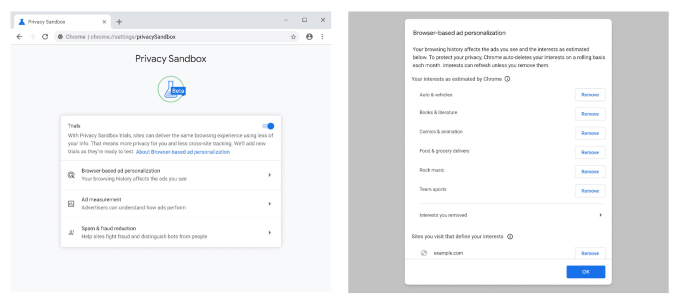Google has just announced the next stage of trials of its Privacy Sandbox proposal — focused on ads relevance and measurement.
The Sandbox refers to an evolving — and now very closely overseen — ad targeting tech stack which Google has proposed for replacing tracking cookie based targeted advertising in Chrome by (at the earliest) the second half of 2023 with alternatives which it argues will be better for users’ privacy yet still effective for generating ad revenue.
Writing in a blog post today, Vinay Goel, product director, Privacy Sandbox, Chrome, said: “Starting today, developers can begin testing globally the Topics, FLEDGE, and Attribution Reporting APIs in the Canary version of Chrome.
“We’ll progress to a limited number of Chrome Beta users as soon as possible. Once things are working smoothly in Beta, we’ll make API testing available in the stable version of Chrome to expand testing to more Chrome users.”
The Sandbox proposal is made up of multiple components, such as Topics — Google’s idea for interest-based ad targeting via browser-based tracking of users’ web activity (which replaced FLoCs; the much criticized antecedent Google recently abandoned) — and FLEDGE, Google’s proposal for remarketing and custom audiences without individual-level user tracking.
As well as being complex and acronym-ridden, Google’s Sandbox plan has attracted no shortage of controversy.
Most notably, antitrust regulators in Europe stepped in following complaints from publishers and advertisers who argue that Google’s plan to deprecate tracking cookies will simply entrench its market power.
But after obtaining a number of commitments from Google over how it would develop the Sandbox (including the appointment of a monitoring trustee), the UK’s CMA signed off on letting the project proceed last month — paving the way for continued development and another batch of Sandbox trials to go ahead now. (Although EU regulators are continuing to scrutinize the plan.)
Google said it will also now begin testing updated Privacy Sandbox settings and controls — which it says will allow users to “see and manage the interests associated with them, or turn off the trials entirely”.
Its blog post gives a sample graphic of some of the settings it will be trialing — which show a multi-layered menu structure with a master toggle to turn off (or on) the trials at the top level and, drilling down, a menu for browser-based ad personalization where a user could remove interests assigned to them by Topics-based surveillance of their browsing activity and edit the list of sites from where the system infers interests, as well as two other menus (one related to ad measurement and another for spam and fraud reduction).

Image credits: Google
Notably, Chrome users in the European Union (and a few other regional markets) won’t be opted in to the latest Sandbox origin trials — and will instead only be able to participate if they actively choose to opt in by flipping the toggle to the on position, per Google. That’s likely owing to the legal protections for people’s privacy in the region, under laws such as the EU’s General Data Protection Regulation.
Trials of the now abandoned FLoCs component of Sandbox last year begun outside Europe too.
“During the upcoming origin trial, Chrome plans to test multiple methods for notifying users about the trials depending on region,” a Google spokeswoman told us. “In the European Economic Area, Switzerland and the UK users will be asked to voluntarily participate in the trials by way of opt in.”
“All users will have robust controls, and can opt out of the trials at any point,” the spokeswoman added.
Whether Google’s approach with Sandbox will truly be privacy preserving is one rather salient and yet to be answered question hanging over the proposal.
There is also the wider issue of whether targeting ads based on inferred interests of individuals (by surveilling their browsing locally) won’t simply replicate the predatory and discriminatory targeting that’s all-too-possible with current individual tracking-based adtech. So how much of a privacy reform/reboot Google’s Sandbox will actually be remains to be seen.
Commenting generally on Google’s proposals, Dr. Lukasz Olejnik, an independent privacy researcher and consultant, said its approach to develop “privacy preserving” ad targeting is drawing on earlier years of research. But he agreed the task is challenging.
“Such research is kind of forgotten now but it was the exciting part of privacy research circles 10-7 years ago or so. It is no longer possible to have an academic publication in this space because it seems that academics consider the problem ‘solved’ for many years now. Well, sort of, however ridiculous this sounds.
“But Google is not interested in having a conference paper, they’re actually building the infrastructure, and this is the challenging part because the web is a complex ecosystem. It’s also quite leaky — so the important part is to propose suitable amendments or additions to the crucial parts of the web architecture to make it privacy proof,” he told TechCrunch.
Olejnik also said Google’s trial announcement underlines at least one notable learning since the tech giant kicked off the Sandbox migration effort a couple of years ago.
“The announcement is also evidence that Google learned the hard way of the importance of user control of tests of the kind, so it is now clear that the users will be in control from the very beginning,” he suggested.
In Google’s blog post, Goel ends by writing that the Sandbox proposals have “benefited substantially from the thoughtful feedback of early testers”, adding that: “We’re eager to open up testing for more of our proposals. We’ll continue to gather feedback from the ecosystem and to engage with regulators globally.”
Developers are pointed to Google’s guidance about the Sandbox APIs and for information about how they can participate in the trials.















 English (US) ·
English (US) ·